精炼、净化过程指去用词之疏误、芜杂,除文句之诘屈、粗陋。汉语讲究炼词、炼句。唐代诗人皮日休倡导“百炼为字(词),千炼为句”。所谓“炼”,就是去芜杂、除粗陋。锤炼词、句的标准是准、精、美。比如译词,如何使用准确、精炼、优美的词语,就体现译者的技巧;能译出来,则只能说是技能。译词通过准、精、美的锤炼达到技巧的过程可如下表所示:

从上列例证我们可以推导出锤炼词语的一些具体手段:1. 词义校正,即纠正措词的偏差或谬误,如上例中的(vii);2. 语义提炼或浓缩,即剔除赘词使用语融汇成更加简练有力的形式,如上例中的(i)、(ii)、(ii)、(iv);3.词语修琢,适当求雅,如上例中的(i)至(iv);4.与成语求切,如上例中的(iv)、(v)。很显然,译者如果没有技能意识的推动,就不可能做出以上种种锤炼的努力。句法上的锤炼也是如此。因涉及的问题太多,我们这里仅就最常见的倾向略举数例加以说明:
(1)译句用词较芜杂、累赘,如:
原句:“当时我刚满二十,年纪轻轻,心想多干一点跑跑颠颠颊的工作,倒也无妨。”(向阳)
(i) 技能水平翻译:用词使人产生累赘感、芜杂感
“At that time I was only twenty and was very young, so I thought that it didn't matter for me to be asked to fetch and carry."
(ii) 技巧水平翻译:运用句子整合、融合法使译句更加紧凑,用词精炼:
"I was only twenty then;but what did that matter when I was asked to fetch and carry.”
(2) 译句结构较松散,层次较拖沓、杂乱,如:
原句:“她向房间那边走去,慢条斯理地跨着步子,突然转回身,望着我说了一声,‘天晚了,抗抗,明天再说吧’,声音轻得好像嘴唇也没有动一动。”
(i) 技能水平翻译:
"She walked to the other side of the room,Her steps were very gentle. Suddenly she looked at me turning around and said: 'It's too late, Kangkang. Good-bye.' Her voice was so very low that I didn't really see her lips move."
(ii)技巧水平翻译:
“She walked slowly to the other side of the room then turned and looked at me;barely moving her lips she said, Good luck tonight,Kangkang.'”
(3)译者缺乏对变通手段(如词类转换、语义增补、删略等)的灵活掌握,执著于同步对应的常规。如:
原句:“对科学而言,验证不仅在方法论上是十分必要的,而且,如果仅仅将验证视为方法论上的程序,那么,科学的结论就可能成为一种因人而异的权宜之计。”
(i)技能水平翻译:
"For science,verification is not only methodologically necessary, but, if it is only regarded as a methodological procedure, a scientific conclusion may become an expediency, which will change because of different scientists."
(ii)技巧水平翻译:
"Verification is not simply a methodological necessity for science. If it were,a scientific conclusion might have become an expediency, which changes from scientist to scientist who chooses it."
从以上各例可以看出,技巧形成的过程实际上正是遣词造句的优化过程。词语选择和句子结构形式的选择往往是熟巧功夫的第一步,也是最基本、最关键的一步。
责任编辑:admin
上一篇:语言的不同之处
下一篇:论过分讲究准确

微信公众号搜索“译员”关注我们,每天为您推送翻译理论和技巧,外语学习及翻译招聘信息。